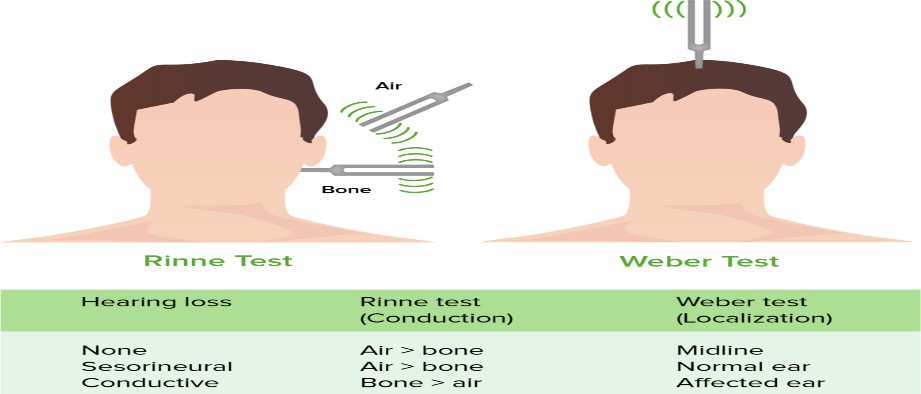A nurse is conducting the Weber's test on a client. Which of the following is an appropriate action for the nurse to take?
Deliver a series of high-pitched sounds at random intervals.
Whisper a series of words softly into one ear.
Place an activated tuning fork in the middle of the client's forehead.
Hold an activated tuning fork against the client's mastoid process.
The Correct Answer is C
C. This procedure helps assess the conduction of sound through bone to both ears, which can indicate whether hearing loss is conductive or sensorineural. The sound should be heard equally in both ears if hearing is normal. If there is unilateral hearing loss, the sound will be heard better in one ear.
A. Not part of the weber’s test
B. Not part of the weber’s test D. Described the Rinne’s test

Nursing Test Bank
Naxlex Comprehensive Predictor Exams
Related Questions
Correct Answer is D
Explanation
D. Auscultating bowel sounds is a non-invasive assessment that can provide important information about the functioning of the gastrointestinal system. It is typically done before palpation because palpation can alter bowel sounds and affect the accuracy of the assessment.
A. While pain relief is important, administering pain medication before a thorough assessment can mask symptoms and make diagnosis more difficult. Pain medication should be provided after an initial assessment and once a clearer understanding of the underlying issue is obtained.
B. Palpating the abdomen is a crucial part of the physical examination, especially when assessing abdominal pain. However, it should not be the first step. Before palpation, the nurse needs to gather more information through less invasive assessments to avoid causing additional discomfort or complications.
C. Administering an antiemetic can help alleviate nausea and vomiting, but similar to pain medication, it should not be done before a thorough assessment. The underlying cause of the symptoms needs to be identified first to ensure that the treatment provided is appropriate and does not obscure important diagnostic signs.
Correct Answer is C
Explanation
C. Wearing a mask when working within close proximity to the client helps prevent the transmission of respiratory droplets containing the influenza virus. This is especially important when providing direct care to the client, such as during assessments or procedures.
A. Metronidazole is an antibiotic used to treat bacterial infections, not viral infections like influenza. Administering metronidazole would not prevent the spread of influenza.
B. Protective eyewear is typically used to prevent exposure to bloodborne pathogens or other bodily fluids that could splash into the eyes. In the case of influenza, the primary mode of transmission is through respiratory droplets, so protective eyewear is not necessary for preventing its spread.
D. Negative airflow rooms are typically used for clients with airborne infections, such as tuberculosis, where there is a risk of droplet nuclei remaining suspended in the air for prolonged periods. Influenza is primarily spread through respiratory droplets and does not require negative airflow isolation.
Whether you are a student looking to ace your exams or a practicing nurse seeking to enhance your expertise , our nursing education contents will empower you with the confidence and competence to make a difference in the lives of patients and become a respected leader in the healthcare field.
Visit Naxlex, invest in your future and unlock endless possibilities with our unparalleled nursing education contents today
Report Wrong Answer on the Current Question
Do you disagree with the answer? If yes, what is your expected answer? Explain.
Kindly be descriptive with the issue you are facing.
